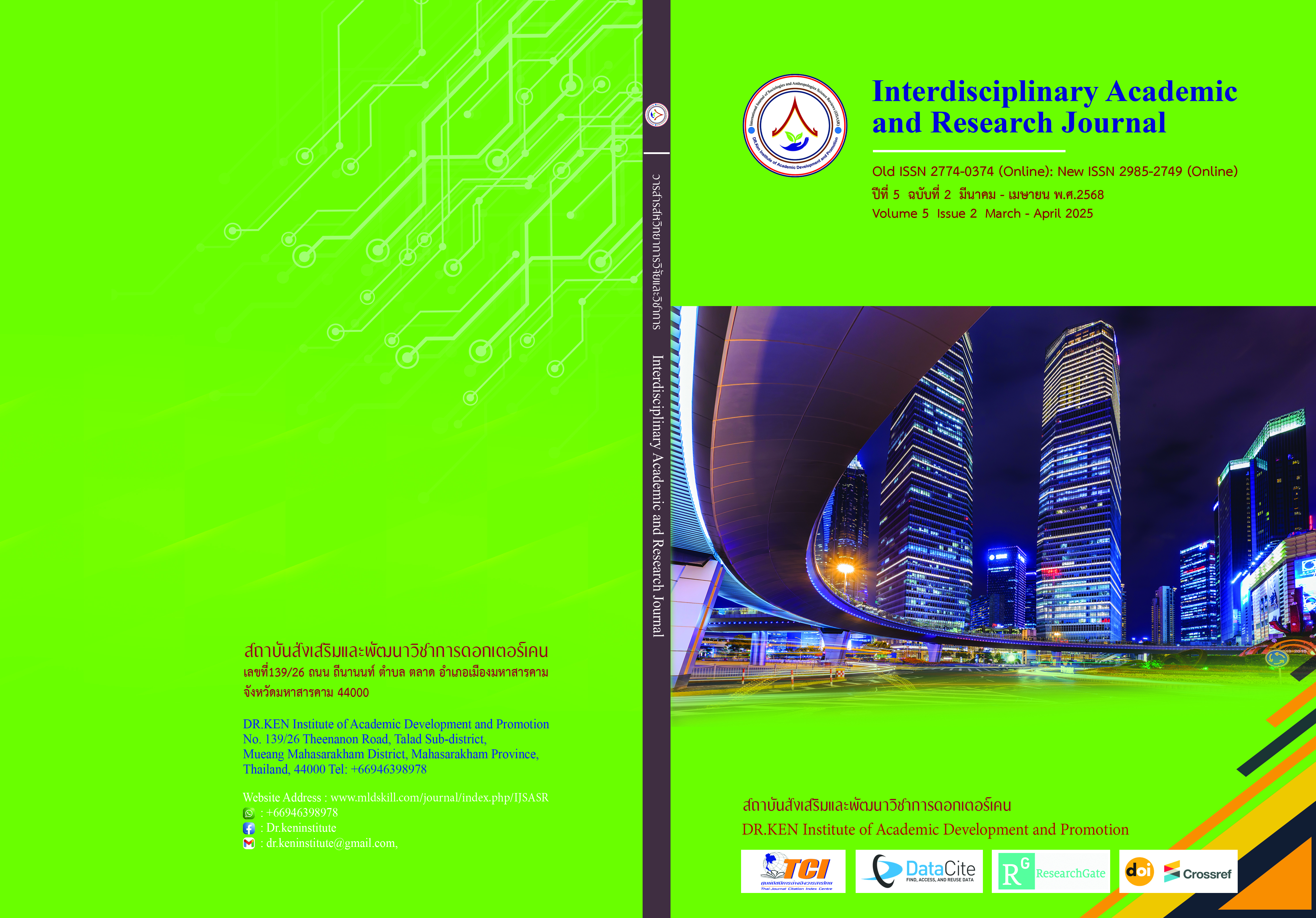A Development Model for Strategic Leadership of School Administrators under the Mahasarakham Primary Educational Service Area Office 1
DOI:
https://doi.org/10.60027/iarj.2025.281555Keywords:
A Development Model, Strategic leadership, School AdministratorsAbstract
Background and Aims: The key attributes that school administrators should possess include strategic leadership, which involves the ability to foresee future developments and set a vision that aligns with societal changes. Additionally, they must have the capacity to formulate strategic plans to provide the organization with clear direction and goals. Therefore, the objectives of this research are as follows: 1) to study the components and indicators of strategic leadership of school administrators, 2) to study the current conditions, desired conditions, and needs assessment for strategic leadership of school administrators, 3) to develop a model for strategic leadership of school administrators, and 4) to study the outcomes of implementing the model for developing strategic leadership of school administrators.
Methodology: The research was divided into four phases: Phase 1 studying the components and indicators of strategic leadership of school administrators with data collected from 5 key informants. Phase 2 studying the current and desired conditions, needs assessment for strategic leadership of school administrators. The sample group consisted of 297 school administrators and teachers. The research instrument was a questionnaire with a reliability coefficient of .87. Data were analyzed using means and standard deviations. Phase 3 development of a model for strategic leadership of school administrators, with input from 9 key informants who evaluated the model’s appropriateness, feasibility, and usefulness. Phase 4 studied the outcomes of implementing the model for developing strategic leadership of school administrators. The target group for this phase comprised school administrators under the Maha Sarakham Primary Educational Service Area Office 1.
Results: 1. The components and indicators of strategic leadership for school administrators include: 1) Organizational direction, 2) Organizational culture, 3) Strategic thinking, and 4) Communication. 2. The overall current condition has an average rating at a high level, the overall desired condition has an average rating at the highest level, and the necessity index ranks from highest to lowest as follows: 1) organizational direction, 2) organizational culture, 3) strategic thinking, and 4) communication. 3. The development model consists of 4 modules: Module 1 Organizational Direction, Module 2 Organizational Culture, Module 3 Strategic Thinking, and Module 4 Communication. 4. The results of the model implementation are: 1) The overall performance evaluation of the components and indicators of the model has an average rating at the highest level, and 2) The overall satisfaction with the model has an average rating at the highest level.
Conclusion: Strategic leadership of school administrators is considered crucial for managing educational institutions and ensuring the quality, efficiency, and effectiveness of education. In the current era, administrators must focus on the strategies employed in management, including strategies for implementing policies within schools. The key components of strategic leadership include: 1) organizational direction, 2) organizational culture, 3) strategic thinking, and 4) communication.
References
กนกอร สมปราชญ์. (2559). (2559). ภาวะผู้นำและภาวะผู้นำการเรียนรู้สำหรับผู้บริหารสถานศึกษา . ขอนแก่น: โรงพิมพ์คลังนานาวิทยา.
กัณฑ์กณัฐ สุวรรณรัชภูมิ, สมชาย เทพแสง, ทัศนา แสวงศักดิ์ และอภิธีร์ ทรงบณั ฑติย์. (2556). ภาวะผู้นำกลยุทธ์: รูปแบบของผู้นำยุคใหม่. วารสารบริหารศึกษา มหาวิทยาลัยศรีนครินทรวิโรฒ.10(18), 1-12.
ชัยพัชร์ เลิศรักษ์ทวีกุล. (2557). ภาวะผู้นำเชิงกลยุทธ์. Retrieved from: http//www.deonetraining.com
ชัยเสฏฐ์ พรหมศรี. (2557). ภาวะผู้นำร่วมสมัย. กรุงเทพฯ : โรงพิมพ์ปัญญาชน.
ธนาชัย สุขวิณิช และพรชัย อรัณยกานนท์. (2557). การบริหารเชิงกลยุทธ์. กรุงเทพฯ: บริษัททริปเพิ้ลเอ็ดดูเคชั่น.
ธีระ รุญเจริญ. (2550). การบริหารโรงเรียนยุคปฏิรูปการศึกษา. กรุงเทพฯ: ธนาเพรส.
นิตย์ สัมมาพันธ์. (2560). ภาวะผู้นำ: พลังขับเคลื่อนองค์การสู่ความเป็นเลิศ. กรุงเทพฯ : โรง พิมพ์ทริปเพิ้ลกรุ๊ป.
ประภาพรรณ รักเลียง. (2556). หลักทฤษฎีและปฏิบัติการบริหารการศึกษา. พิษณุโลก : มหาวิทยาลัยพิษณุโลก.
ปรีดี นุกุลสมปรารถนา. (2564). คุณลักษณะของผู้นำเชิงกลยุทธ์ (Strategic Leadership). Retrieved September 15, 2021 from https://www.popticles.com/business/strategic-leadership-.characteristics/
ไพศาล วรคำ. (2559). การวิจัยทางการศึกษา. พิมพ์ครั้งที่ 8. มหาสารคาม : ตักสิลาการพิมพ์.
รังสรรค์ ประเสริฐศรี. (2561). ภาวะผู้นำ. กรุงเทพฯ : ธีระฟิล์มและไซเท็กซ์.
วิโรจน์ สารรัตนะ. (2557). ภาวะผู้นำ ทฤษฎีและนานาทัศนะร่วมสมัยปัจจุบัน. กรุงเทพฯ: ทิพย์วิสุทธ์.
สมชาย เทพแสง. (2556). ภาวะผู้นำเชิงระบบ (System Leadership) : รูปแบบที่มุ่งคุณธรรมสู่ความเป็นมืออาชีพในหลักวิชาชีพทางการศึกษา. กรุงเทพฯ: บริษัท พี.เอ.ลีฟวิ่งจำกัด.
สมาน อัศวภูมิ. (2550). “การใช้วิจัยพัฒนารูปแบบในวิทยานิพนธ์ระดับปริญญาเอก” ในเอกสารประกอบการสอนวิชาสัมมนาการศึกษาระดับปริญญาเอก. หน้า 50-53. อุบลราชธานี: มหาวิทยาลัยราชภัฏอุบลราชธานี.
สำนักงานเลขาธิการสภาการศึกษา. (2565). กรอบคุณวุฒิแห่งชาติ. กรุงเทพฯ : สำนักกรอบคุณวุฒิแห่งชาติ สำนักงานเลขาธิการสภาการศึกษา.
สิริกร ไชยราช. (2562). การพัฒนารูปแบบการพัฒนาภาวะผู้นำครูในการจัดการเรียนรู้ตามหลักปรัชญาของเศรษฐกิจพอเพียง ในโรงเรียนมัธยมศึกษา สังกัดสำนักงานศึกษาธิการภาค 11. วิทยานิพนธ์ครุศาสตรดุษฎีบัณฑิต: มหาวิทยาลัยราชภัฏสกลนคร.
สุเทพ พงศ์ศรีวัฒน์ (2558). ภาวะความเป็นผู้นำ. กรุงเทพฯ : เอ็กซเปอร์เน็ท.
สุวิมล ว่องวาณิช. (2558). การวิจัยประเมินความต้องการจำเป็น. กรุงเทพฯ : สำนักพิมพ์แห่งจุฬาลงกรณ์มหาวิทยาลัย.
Adair, J. (2010). Strategic Leadership: How to Think and Plan Strategically and Provide Direction (The John Adair Leadership Library). London: Kogan Page.
Anderson, T. P. (1997). “Using Models of Instruction. In C. R. Dills and A. J. Romiszowski (eds)”. Instructional Development Paradigms. Englewood Cliffs, NJ: Educational Technology Publications.
Bass, B. M., & Avolio, B. J. (Eds.) (1994). Improving organizational effectiveness through transformational leadership. Thousand Oaks, CA: Sage Publications.
Dess, G.G., & Alex, M. (1993). Strategic Management. Singapore: McGrew-Hill.
Dubrin, A.J. (2007) Leadership Research: Findings, Practice, and Skills. 5th Edition, Houghton Mifflin Company, Boston.
Eisner, E. (1976). Education Connoisseurship and Criticism: Their Form and Function in Education Evaluation. Journal of Aesthetic Education. 10 (4), 135-150
Hitt, M. A, Ireland, R. D., & Hoskisson, R. E. (2007). Management of strategy: Concepts and Cases. China: Thomson South-Western.
Johnson, G., & Scholes, K. (2003). Strategic Management in Practice from Exploring Corporate Strategy. 6th ed. London: Prentice-Hall.
Joyce, B., Weil, M., & Calhoun, E. (2004). Models of Teaching (7th ed.). Boston: Allyn and Bacon.
Perce, A.J., & Robinson, R.B., Jr. (2007). Formulation, Implementation, and Control of Competitive Strategy. 11th edition. New York: McGraw-Hill.
Yukl, G. (2006). Leadership in Organizations. 6th edition. New York: Courier Stoughton.
Downloads
Published
How to Cite
Issue
Section
License
Copyright (c) 2025 Interdisciplinary Academic and Research Journal

This work is licensed under a Creative Commons Attribution-NonCommercial-NoDerivatives 4.0 International License.
Copyright on any article in the Interdisciplinary Academic and Research Journal is retained by the author(s) under the under the Creative Commons Attribution-NonCommercial-NoDerivatives 4.0 International License. Permission to use text, content, images, etc. of publication. Any user to read, download, copy, distribute, print, search, or link to the full texts of articles, crawl them for indexing, pass them as data to software, or use them for any other lawful purpose. But do not use it for commercial use or with the intent to benefit any business.














.png)

